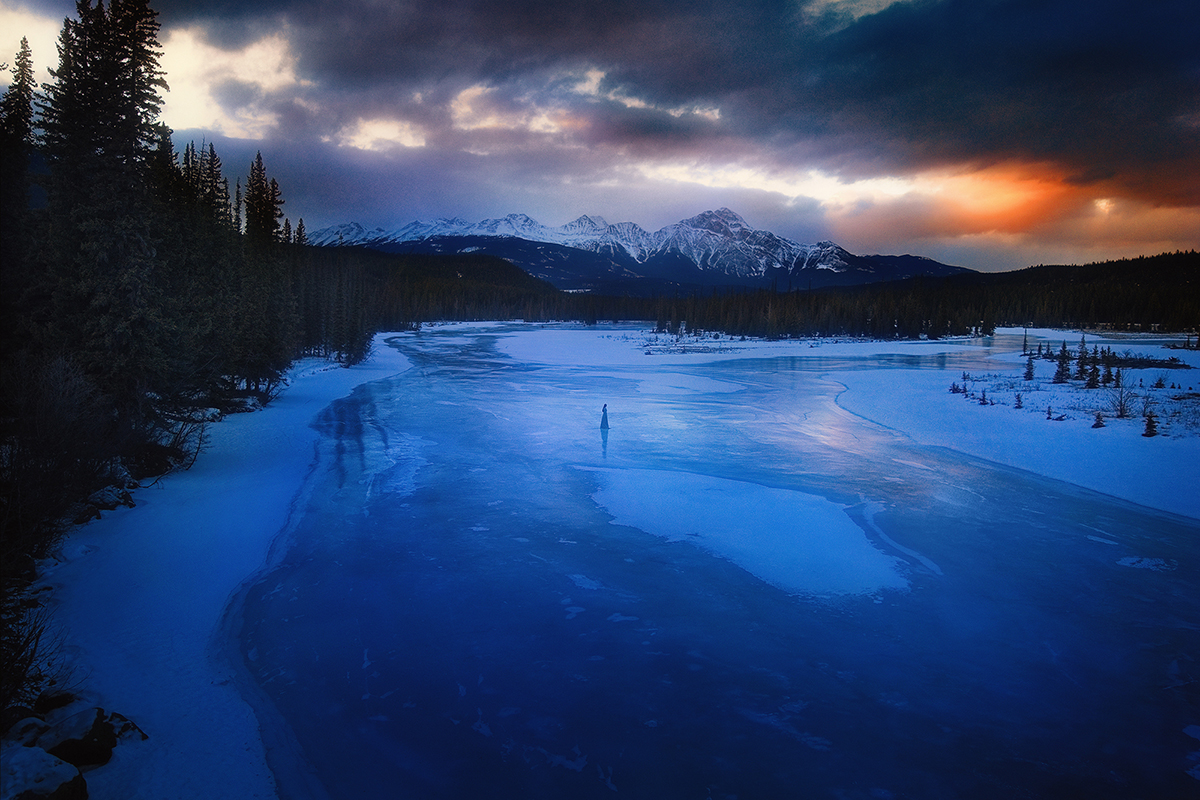How to: Enhance Images in Post-Production
TJ Drysdale and Victoria Yore head into the Canadian Rockies with the Tamron SP 15-30mm F/2.8 VC Wide-Angle Lens.
By Jenn Gidman
Images by TJ Drysdale
When TJ Drysdale and Victoria Yore first met in Tampa in 2014, he was looking for models for his photo shoots and she reached out. They started working together, then became friends, and about a year later they headed off to Europe for a change of scenery for their photo shoots. A trip to North Carolina in October 2015 followed, and by January 2016 they'd started their two-part "Follow Me Away" series: a travel blog and Instagram page that documents their mission to see the world.
"We started posting all of our pictures from these trips, then traveling more, and the series just took off," TJ explains. "What's funny is I look back on those images and they're already so different from how I shoot now. It's cool to see how my work has evolved."
When TJ and Victoria first headed to Europe, the widest lens he had was a 50mm. "That limited the amount of landscape I could get in my images," he explains. "With the Tamron SP 15-30mm F/2.8 VC Wide-Angle lens, a whole new world opened up for me. That's because I want to tell a story with each image, to make the viewer ask: Why is this girl out here in this dress, with this vast landscape behind her? With the 15-30, I can get even more of that landscape behind her and tell more of the story."
He applies most post-production to his images himself, though he notes that Victoria isn't shy about offering her opinions into the mix. "I agree photographers should try to get as much of the image right in-camera," he says. "But these days, to make your work unique and stand out, you have to know how to wield your post-production skills. I would say my workflow is about 40 percent picture-taking, 60 percent post-production. I shoot in RAW, use Adobe Camera Raw to bring out the colors and add details into the sky, then import the images into Photoshop, where I have various techniques I use to further enhance the photos."
TJ has an overall goal in mind when he's working on his images. "I'm really inspired by 19th-century art, like those fantastic paintings you see in art magazines," he says. "I always try to have my photos resemble that kind of work, complete with those incredible color palettes."
TJ and Victoria have several other trips this year they're mulling—including possible adventures to Peru, Alaska, and Arizona— and he's looking forward to using the 15-30 on those journeys as well. "I can't wait to see what I can capture with this lens in so many different, exotic locales," he says.
Read on as TJ details the background behind each image he took on a recent trip to the Canadian Rockies, and how he enhanced them in post-production to achieve his trademark ethereal feel.
This first picture was taken in Jasper, because our train heading to Vancouver that day was delayed and we had lots of time to kill. We had three different dresses at our disposal: a white one, a red one, and a gray one. I decided I wanted Victoria to blend more into the landscape, so we eventually went with the gray dress. I simply had her walk about 100 feet in front of me. The wide angle of the 15-30 makes her look much smaller in the frame than she actually was.
It started snowing really hard as we were shooting. You can see that more in the background where she's standing. I made minimal post-production changes to this image. It was overcast, but the fact that it was snowing really helped—the ground being so white helped reflect more light. All I had to do was bring that brightness out a bit more in post.
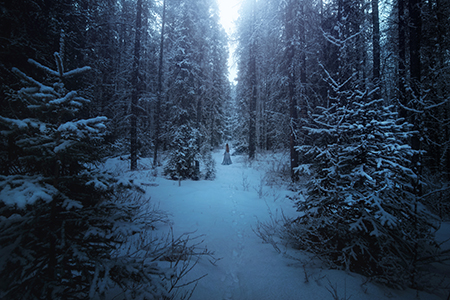
16mm, F/5.6, 1/250th sec., ISO 200
There are Class IV rapids at Jasper's Maligne Canyon during the summer, but in the winter, the ice is nearly 10 feet thick. There's something that happens underground that helps keep the ice that thick. I took this photo at around 9 a.m., when the sun was just starting to break through the clouds. This image was originally one of my outtakes, as I really liked the pictures taken outside of the canyon better. But when I was going through the images later, I saw this one and couldn't believe I had missed it the first time around.
I was actually closer to Victoria than I usually am. I didn't really change the color in the foreground that much, because I basically liked what I saw there—I just made it a little more vibrant. Where the sun pokes through, however, I enhanced it quite a bit to help give it more of an orange hue and show off the haze coming through the canyon walls.
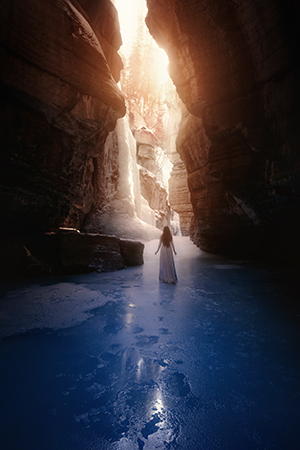
22mm, F/6.3, 1/100th sec., ISO 320
This sunset shot was taken on a frozen lake right outside of Jasper. It was scary being out there because we felt like the ice could crack at any minute, though some locals told us as long as it was an inch thick, we'd be fine. I threw a rock as hard as I could at it anyway, and the rock broke, so I figured we were safe. The only other worry we had were the wolves we'd seen from the train, but they stayed away that day.
Victoria stayed on the lake while I drove back up to the road to take the picture from a bridge near the lake. The sun had already set, which helped create those blue tones, but I was high enough so I could capture the sun on the clouds in the upper right. The ice was so reflective you could see a bit of orange on there as well.
The original picture had natural blue tones that weren't that vibrant, so this took the most post-production work out of all the images you see here—it was just a matter of figuring out which shade of blue was most desirable. I wanted it to look surreal but natural at the same time. I did bring out the colors quite a bit, but with just a few enhancements to keep everything as natural as possible.
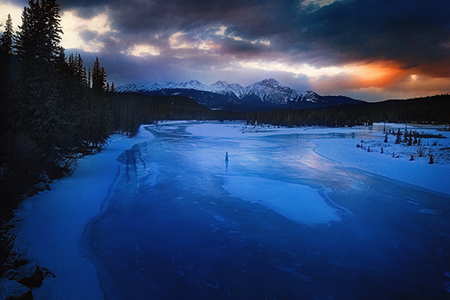
30mm, F/5.6, 1/200th sec., ISO 320
At Vancouver's Lynn Canyon Park lies a suspension bridge built in 1912, hovering 165 feet over the abyss. It was the first time I'd ever been up that high on a bridge like that. This time I had Victoria wear the red dress to stand out more, and I just started taking pictures as she walked out onto the bridge. Once again, it started snowing as we were shooting.
As far as post-production goes, I definitely darkened parts—I wanted to create a natural-looking vignette around the image. I changed the colors of the greens a little, too, to make them darker than they actually were. I wanted to create more of an ominous mood, almost asking: "What is she walking into? What's on the other side of this bridge?"
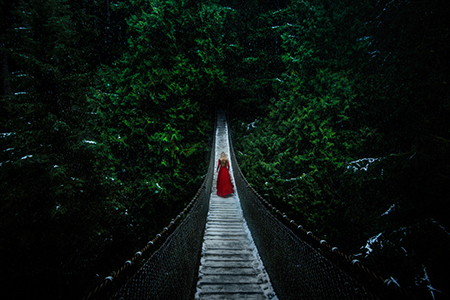
20mm, F/2.8, 1/250th sec., ISO 400
This photo was taken at the Athabasca Glacier, located on the largest ice field in the Canadian Rockies. The sun was setting early at this time of year—around 5:30 p.m.—so I took this photo at around 3:30. It was one of the most amazing sights I'd ever seen.
I took this photo at one of the widest focal lengths this lens could offer. I had to do quite a lot in post-production here. First of all, there were many footprints that I had to remove, because we were running around a lot. Plus, it wasn't naturally that cool-toned out there; the original image was pretty warm. In fact, even after I took the picture, I only envisioned it in warm tones. Then, when I sat down at my computer and started to work on it, I was just curious what it would look like in a cooler tone. When I switched it up, I was like, "Wow!" I liked it a lot better. Many people have told me that when they see this image, it looks like it's another planet, or on the moon.
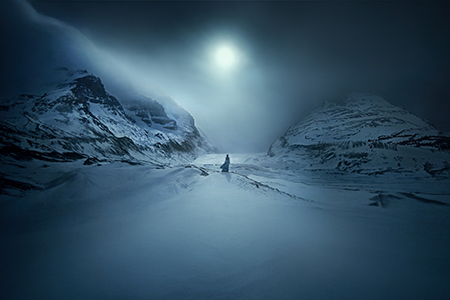
17mm, F/7.1, 1/2500th sec., ISO 100
For our trip to Niagara Falls, we were on the Canadian side, standing at one of the viewing spots that overlooked the New York side. It was pretty cloudy that day, and the sun was just barely broken through when I took this photo—you can see the light hitting the waterfall, making the whites a little bit brighter. It was an ideal shooting situation. I love that kind of light. I had to amp up the colors a bit to create some atmosphere, but not too much. It was just a naturally cool environment, as anyone who's ever been to Niagara Falls knows.
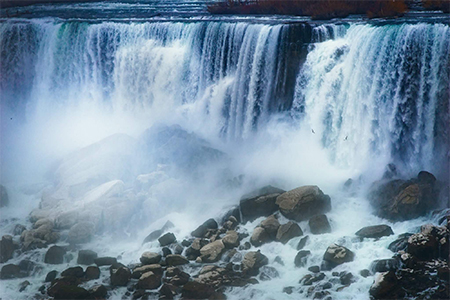
30mm, F5, 1/4000th of a second, ISO 400
To see more of TJ Drysdale's work, go to www.tjdrysdale.com or follow him on Instagram at www.instagram.com/tjdrysdale.
